Samuel Evensen

Can you tell us a little bit about your background? Where are you from and how did you get interested in painting?
I was born in Orem, Utah. I grew up in Utah and started painting when I was a teenager, studying with Utah painter Joseph Brickey—a phenomenal painter. Eventually I went to BYU and studied in the illustration department.
I graduated there and came out to New York and studied at the New York Academy of Art, receiving an MFA in painting, a two-year program.
How did that compare to your education at BYU?
For me it was a real stepping-stone into the kinds of things I’m pursuing now. BYU’s program was great. I studied in the illustration department because I was interested in working with the human figure. I had friends who had been through the program who encouraged me to do the same because of its emphasis on the human figure and focus on traditional methods of painting. Yet I always felt much more like a fine arts painter than an illustrator. I never really had serious interest in illustration, so some classes didn’t fit me so well. When I came to New York and began studying at the New York Academy of Art I felt suddenly right at home.

The Academy’s program is focused primarily on the human figure and more traditional methods of painting, drawing, and sculpture. They teach a comprehensive history of art practice and theory from pre-Renaissance to contemporary movements.
The goal there is to supply the artist with traditional skills of visual articulation and then encourage him or her to find a contemporary application for them. There’s a lot of emphasis in contemporary relevance and I liked that a lot.
Not necessarily contemporary media and methods like abstract painting or new art, but just trying to make the figure applicable to today’s world, as in Richard Prince or similar artists?
Yes. The figure has become more and more popular in the broad art world in recent decades. Representational painting and using the human figure is quite ubiquitous in contemporary art.
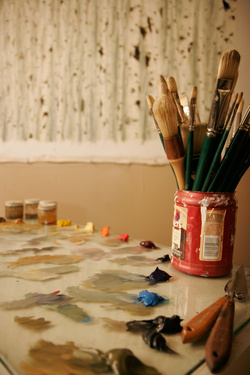
Do you see that as a bit of a reactionary movement responding to several decades of abstraction or de-emphasis of the figure?
Maybe. Post-modernism is a really interesting phenomenon and the return to the figure is probably due to the fact that post-modernism really includes just about everything.
I believe art critic Arthur Danto defined it well when he wrote about how he views contemporary art as a post-historical era, meaning that a progressive linear development in art history was essentially dissolved following modernism. I don’t subscribe to all his ideas, but that one does make sense. Basically he says we now live in an almost-anything-goes art world with no major stylistic imperative as has existed throughout most of art history.
That creates some confusion with an ever-expanding definition of art, quickly blurring the lines between traditional ideas of visual arts and other related or non-related fields.
The legitimization of so many varied forms of art affords contemporary artists liberty to do just about anything, including a return to figuration and traditional painting methods.
So maybe it’s a reaction but I think of figuration more as a byproduct of that expansion of art from modernism, the era of manifestos and self-definitions, to post-modernism, the era of pluralism.
Given that pluralism, what do you personally like to go see in museums and galleries here in what is arguably the artistic capital of the nation?
I like to go see the Metropolitan Museum of Art and the Frick because of my interest in traditional methods of painting. I try to see a lot of what’s happening at the other major museums—the MoMA, the Whitney, the Guggenheim, the New Museum, and so forth. I love going at least weekly to gallery openings around the city, particularly in Chelsea.
I love to see new work and what various artists are doing now. Some of it I love, some of it I hate, and some of it I’m kind of indifferent about, but it’s always very engaging and stimulating for me to be able to see as much as possible. I’ve come to view my work as part of a dialogue that began hundreds of years ago. I try to create works that dialogue with both living and non-living artists. That’s an idea that’s grown out of academic scholarship, of course, and may sound a little goofy, but I think the idea is accurate—and it’s exciting to think of my work as a response to a great artist of the past or present or as part of a contemporary debate of visual ideas. So I try to see as much as I can, really.
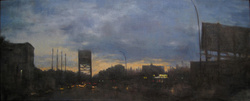
What were your early influences as you were starting out, as a teenager and as a student?
First, I have incredible parents who always encouraged me in my interests in the arts. Their love and support helped me feel like art was a legitimate career and worth pursuing.
As I said before, I studied with Joseph Brickey. During my time with him we studied a lot of nineteenth-century classical realists. I had an affinity for the masters throughout art history and studied a lot of artists from the middle and end of the nineteenth century, artists like Sargent, Bouguereau, Alma Tadema, and Waterhouse.
Since coming to New York my tastes have expanded dramatically. I realized that, almost as a default, I had been composing pictures through a very neo-classic modality. I was anxious to explore other compositional modes and visual languages. I now find myself ever more attracted to abstraction, expressionism, and other contemporary movements.
Really, I’m a painter at heart and find that I favor painting over other forms. I also think I will always be a representational figurative artist but I find myself more and more influenced by a broad spectrum of artists from Michelangelo, Velázquez, and Manet to Picasso, Philip Guston, Anselm Keifer, Cy Twombly, and Vincent Desiderio.
I’m most attracted to painting that explores the expressive and emotional qualities of the medium and artists who deal with an internal “innernecessity,” as Kandinsky put it.
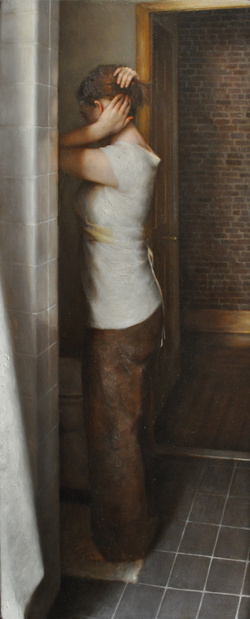
Tell us about your workspace.
My studio is a room in my apartment exclusively dedicated to my work. I’m here working in the studio usually six days a week—whenever I’m not teaching. I try to capitalize on the space by tacking paintings to the wall as opposed to using an easel.
I find that I prefer working on a variety of works concurrently for practical reasons like letting paint dry as well as for conceptual and creative ones—if I get stuck with an idea I can go to something else. So I try to fill my walls with paintings that are still in progress. I also have a wall covered with sketches and different ideas mulling around in my head.
I guess I kind of see my studio as an extension of my creative mind. I have works and ideas all around that I’m in the process of completing or figuring out. It’s a great space for me.
Do you have a favorite medium? Do you like working with oil?
I almost exclusively work in oil paint. I can’t put the stuff down—it’s so exciting. I love the versatility of oil. You can do countless things with it. I really believe it’s clearly the most versatile paint medium.
I’m attracted to painting and drawing specifically because it visualizes the individual voice of the artist. In fact, that’s one of my concerns with contemporary art and new media.
New media art has the potential to hide the individual voice. In contrast, I feel like oil paint makes that voice very salient in the creation of art, the construction of a picture.
With most painting and drawing media the individual voice of the artist can be very conspicuous and very clear through an infinite application. That’s very important to me as an artist.
Which you don’t get if you look at a Duchamp urinal or something like that.
Right. That kind of masks the individual voice in a way. Duchampian thinking doesn’t deal much with individuality and expression. It’s more of a conceptual Gordian knot that is much more literary than visual. In essence, Duchamp created a world of ideas now supported by written theory.
Conversely, I seek to make work that reaches to some degree beyond the scope of words. I’m interested in art as experience—visceral experience, I suppose—that transcends the confines of literature. That’s what makes the visual arts uniquely powerful for me.

Would you ever be tempted to do anything three-dimensional?
Probably in the future. I’ve done some sculpture in clay, but not enough to consider myself a real sculptor. I’ve always dreamed that in my other life, if I had another life, I would be a sculptor. But right now I’m dedicating myself to painting.
Let’s talk about some of your specific paintings. You have a large canvas hanging in your living room of the skyline of Washington Heights as seen from the Columbia medical towers. It’s a rainy scene and there are areas of very precise detail and others where it almost looks like a Turner in the blending of the tones and the wash over the buildings. How did you go about approaching that piece?
The work is called simply Rain. The idea originated with a choral piece about a rainstorm by composer Eric Whitacre entitled Cloudburst. A lot of my work is actually derived from music; in fact, a lot of formal ideas that I use in my work are derived from formal ideas I hear in music.
But this particular painting is derived from that song about a cloudburst, a rainstorm, which is really arresting to me. I was thinking about rainstorms and the metaphor in that song; the lyrics talk about the earth being very dry and thirsty, yearning for water. At the end of the piece the singers mimic a rainstorm that comes and cleanses and renews the earth. It’s an incredible moment and a very iconic idea, of course. And to me it’s a metaphor for revelation and the interaction between heaven and earth.
In Rain I tried to translate those ideas into a visual form. A painting about revelation is really about the physical and the spiritual worlds and how they meet and interact with one another. In the painting itself there are passages that are very clear and other passages where the light and the imagery are diffused and refracted through the rain that’s coming down. I wanted to create what rain felt like, not just what it looked like.
I really like that play between a concrete physical reality and a metaphysical, spiritual reality, or a kind of Turner-esque sublime reality. I was interested in portraying the intersection where the two realms meet and comingle—the essence of spiritual experience.
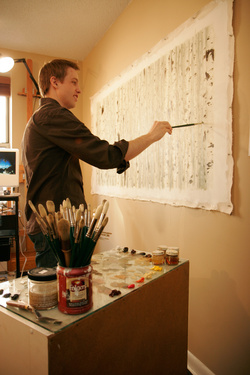
Overall, I tried to create the imagery so that the city and the sky and the rain coming down would interact with each other and there would be places where that interaction is blurred, where it’s difficult to tell what is what. So there’s a lot of representational painting as well as a lot of abstraction within this one piece.
To me the work also explores themes of faith. It’s a fairly large piece—50 × 132 inches—and I composed the imagery in such a way that when looking at it the viewer becomes enveloped in the picture—unable to take it all in at a reasonable distance.
I originally designed it with a male figure on the edge of the building in the foreground but finally removed him in an effort to allow the viewer to be the figure in the painting.
I wanted the rainstorm to be at once formidable and beautiful. I wanted the viewer to feel exposed and maybe a little vulnerable. It requires faith to trust in God and follow Him. Faith often asks us to proceed before we completely understand; it promises stability only through vulnerability. In this painting I’m exploring that state of coexisting vulnerability and stability—vulnerability because of the unknown and stability because of a spiritually discerned transcendent reality. A lot of my work actually has to do with the idea of finding or defining spirituality as the place where the physical and the spiritual worlds meet together and interact with one another.
Do you see that as one of the primary ways in which the gospel influences your work?
Absolutely. I fundamentally believe that every painting at its most basic level is a self-portrait of the artist, no matter the imagery or the style. It’s impossible to not depict to some degree who we really are.
Because my worldview is defined so much by the gospel I think it’s inevitable that those ideas will come forward…even without my having to consciously pursue them.
Are there any particular components of the gospel that draw you toward that type of subject matter? It seems to me that such doctrines, about spiritual manifestations in the physical world, could really influence an artist. The reason I like Turner, for instance, is that he helps you see beyond the flat surface of the painting. Is it fair to say that would be the dominant way in which you approach your painting?
Yeah, I think so. Not all my work begins with spiritual doctrines, but as I said before, it’s difficult to remove those entirely from my work. I think of much of my work almost like sculpture. I like thinking about creating an object, not just creating an image. That physicality is important to me.
But as much as I’m interested in formal elements of making art, I believe I’ll always be a representational artist, creating works with some degree of verisimilitude. I just think that way.
Those two ideas of physicality and illusionism are really interesting to negotiate in the same space. I think there are a lot of parallels to the gospel inherent in those ideas.
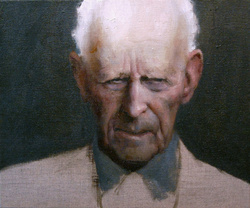
Tell us a bit about your painting Veil. It features the trunks of a grove of quaking aspens, essentially creating a field of white bark and dark knots and markings.
This painting began with just an image. It’s derived from another piece I did called Populus Tremuloides with similar imagery. I wanted to create a painting of aspen trees where you couldn’t see the roots and you couldn’t see the tops or branches; it was just an infinite number of tree trunks. I wasn’t exactly sure why I was so attracted to that image, so I decided to begin painting it and explore what it meant.
I really liked the idea of the aspen trees being one organism connected through a common network of roots so that technically the aspens were all branches of the same plant. I thought that was really engaging and struck at something fundamentally iconic.
I became fascinated with the formal design of the piece. I liked the long, horizontal format that encourages your eye to move back and forth and the vertical lines that encourage your eye to move up and down. Furthermore, I really liked the play of the dark knots placed sporadically on a field of white trees that forces your eye to bounce around to different resting places in the painting. So, from a formal standpoint I really liked how activated the imagery was.
As I worked it seemed to me the image of scores of trees was exciting and inviting but also kind of prohibitive, almost like a wall. Still, the trees aren’t lined one against the other to create a barrier. One can enter into the illusionism of the space. It occurred to me that this image was a metaphor for a veil.
The veil is a barrier which blocks vision but can also be passed through. That opened up the work in whole new ways for me. I tried to emphasize how a veil is something that separates the physical and the spiritual realms. And, because of that, it’s also the place where the physical and spiritual world can interact with one another when the veil is breached.
So I tried to have areas where the paint is very flat and very modernist, where it asserts the two-dimensional plane of the canvas. In other areas the image is more illusionistic, implying a traditional perspectival space.
I tried to make that juxtaposition with an internal and external narrative: an internal narrative where there’s a perspectival, illusionistic space and an external narrative where the painting again asserts its physicality as a flat object. This physicality is a bit like sculpture, or at least references sculpture. That play between a repellant flatness and an inviting illusionism is really what this painting is all about for me.
Additionally I like how this metaphor implies that a veil isn’t something we pass through at once but by degrees just as you can enter the illusionistic space of the painting by passing through the trees one by one, sort of a visual idea referring to the “line upon line” principle.
A lot of great religious painting has emphasized its flatness; that’s one of the fundamental characteristics of icons, after all. Do you think it’s easier to access a level of spirituality when emphasizing the flatness of the canvas, like the flatness of a veil? Or do you feel similar levels of spirituality with your figure drawings and other works that include perspective?
That’s an interesting question. I didn’t mean for this painting to function the same way as a devotional image. Icons similarly assert their flatness but are more emblematic, directing the viewer’s spiritual gaze to the ineffable.
This painting, on the other hand, attempts to imply the path to the ineffable through implied classical perspective and illusionism. Originally this was part of the philosophy behind perspectival construction: creating a connection between the viewer and the infinite—in my case, God. To me this work is more about the play between the two worlds of flatness and illusionism—where I’m trying to capture the essence of both worlds, one that you can enter and one you cannot. I’m using both as metaphors. As we pursue faith and spiritual living we can pass through a veil and have an interaction with the Spirit, yet we’re still living in a physical world that determines the majority of our sensory experience.
I don’t want to sound too ascetic, like the physical body is evil. To me it’s quite the opposite—that we have spiritual interactions with God while remaining in a mortal, physical existence. Those two can coexist and allow us to become more like God.
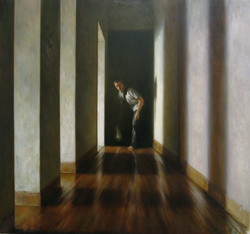
It’s more about seeing things with a spiritual eye, even when you’re in a physical world.
Right. And having the physical and spiritual interact—not necessarily that we strip ourselves of all things physical.
There is a longstanding tradition of asceticism in Christianity with the resulting debate over what role visual art should play. Some denominations have embraced art while others have shunned it, as in the historical conflict between icons and iconoclasm. How do you feel about the way visual art plays into the LDS culture and lifestyle?
I hope it plays a big part. I believe that with a worldwide church it’s becoming increasingly difficult to wrap parameters around LDS culture. But I hope that visual art and all the arts are a big part of LDS pursuits.
LDS doctrine embraces the physical body and physical world as gifts from a loving God. Of course, the majesty and importance of the physical body is manifest in Christ’s resurrection. So, unlike some denominations, LDS doctrine encourages full involvement in the physical world.
Still, our art objects aren’t meant to function as devotional images of the past. We don’t worship them, but hopefully they do to some degree direct our minds to higher levels of thinking about ourselves, others, and our world. I believe the greatest artists from all generations don’t create work that is only a reflection of our world and the times we live in. Great artists create work that is more transcendent and revelatory—it reaches somehow beyond our current state to create a new vision of thinking and feeling and experience. I hope my work functions that way.
What is it like being an LDS artist working here in New York City, an environment some would say isn’t conducive to creating moral or spiritual work?
It’s great! It hasn’t been my experience that the “New York art world” is entirely indifferent about moral and spiritual matters. I suppose different people have different perspectives. As an LDS artist I initially wondered how my faith, which was reflected in my work, would be accepted and treated. I’ve personally found a very warm reception to my work and interests, including pursuing my faith and LDS identity in my painting. I have found it very enlightening and a very positive experience.
Of course, because of technology that affords a global perspective and an ever-heightening sense of pluralism, there really is no longer one “art world.” There are many art worlds and no doubt there are certain communities where my work wouldn’t be valued as I hope it will. But the art communities I’ve interacted with have been very warm and receptive.
Overall I feel that what I do is appreciated, as long as the quality of the work not only matches the content but also functions well as visual art.
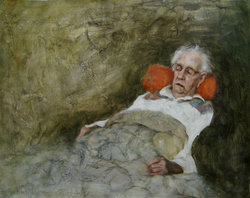
Are there other LDS artists, either historical or contemporary, that you highly regard?
I will always be in debt to Joseph Brickey for what he taught me as a painter. Virtually everything I’ve learned about painting itself came out of my years of study with him. I enjoy Minerva Teichert’s work. I also think J. Kirk Richards thinks very creatively and is very innovative about composing historical narratives. I listen frequently to BYU Singers and feel my painting is somewhat influenced by the work Ronald Staheli does.
How do you relate to the community of LDS visual artists? Is it possible to say there even is such a thing?
It’s possible to speak in terms of a community of artists because we share common beliefs and interests concerning our religion even if we differ when it comes to our art.
That said, I see myself as a visual artist who doesn’t paint exclusively for an LDS audience; I therefore see myself interacting both with LDS and non-LDS artists, and with LDS and non-LDS, even non-religious, audiences.
Some Mormons speak about a requirement or a kind of duty for LDS artists to be making specifically LDS art, or at least to be building up the kingdom of God with our art. It’s my feeling that there’s no one single way to approach that.
I mean, when we talk about building the kingdom of God I think that happens first and foremost in our families.
So being a loving husband and fulfilling my duties as a father in teaching and working to provide for my family is building the kingdom of God—the most important part of building the kingdom of God that I’ll ever do.
My work is certainly a reflection of my LDS identity but also my identity as a child of God living in a mortal world.
As an LDS artist I pursue ideas that are universal, for example the ideas of spirituality and spiritual experience that I’ve been discussing. I think it’s very rich to interact with both LDS and non-LDS audiences in regards to those types of experiences, but not necessarily in an overtly didactic sort of way.
I feel like we all have a universal shared experience as a human family and as children of God, and sharing that experience with one another is really rich and exciting, regardless of our denomination or our belief system. I suppose that common experience is what excites me so much.
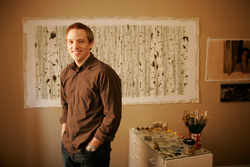
So it helps broaden our scope when we have LDS artists doing things that are not overtly LDS in content but which can speak to doctrines, themes, and emotions that we have?
Yes, among other things. I also think one of the most exciting things about the Church is that we are nothing without our history, and I mean the history of the modern Church beginning with Joseph Smith as well as the history of the God’s dealings with his children going back to Adam.
But we are also nothing without the present, without contemporary experience, because everything we strive to do is applied religion—the attempt to live our faith, to help and strengthen each other as a human family.
So I believe there’s a place for historical narratives in the visual arts, but it’s just as critical that there be a forum where artists can also create works that are about contemporary life and what it means to be living now as a member of the LDS Church.
More universally, our art should deal with what it means to be a child of God living on the earth, sharing in a mortal experience; in that way we apply religion to our present condition, as opposed to solely examining its historical value.
Both are valid within and without the Church. I think both are important and support each other, but in my own work I’m drawn more and more to contemporary issues and imagery, more to universal themes than historical narratives or, as you put it, overtly LDS content.
What are you working on now?
As I said, I tend to have several projects underway at once.
But in general I continue to pursue this idea of spirituality and veils, so I’m actually doing a series of veils right now. I have one underway that depicts fish in a rather abstract fashion, painted on four panels. That’s one work in a whole series of pieces about veils.
I also just recently began a figurative series in response to the earthquake in Haiti, as well as the earthquake that happened just this morning [February 27] in Chile.
This is something I’ve never really done before. I’ve never approached my work this way where I’m creating the bulk of the material out of my head. It’s really not so much a depiction of the events of the Haitian earthquake as much as of my experience when I found out about it, as I watched CNN trying to get information.
I was in Spain that night and of course there were no real answers or images or communication at that point. Reporters continued to describe the event and talk about what it must have been like, but they were unable to do much more than guess—as we all were, so far removed from the event.
The work represents my response as I tried to imagine what it was like for the Haitian people. So the imagery is based on my imagination of the experience and my personal response as I felt so devastated about the event, urgently wanting to help in some way.
It’s a very, very different approach from most of the other things I’ve done and I think the imagery is therefore very different. But I’m excited about it: there’s a lot of potential for really arresting ideas. It’s a little more horrific and terrifying than some of my other work, which is more contemplative. ❧
